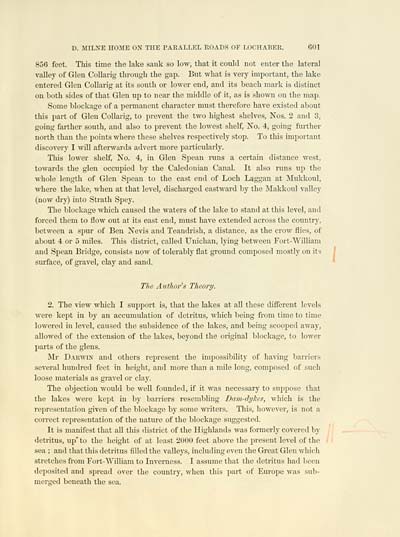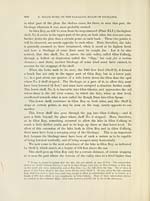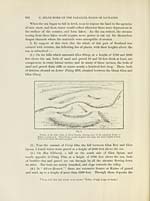Download files
Complete book:
Individual page:
Thumbnail gallery: Grid view | List view

D. MILXE HOME ON THE PARALLEL ROADS OF LOCHABER. 601
856 feet. This time the lake sank so low, that it could not enter the lateral
valley of Glen Collarig through the gap. But what is very important, the lake
entered Glen Collarig at its south or lower end, and its beach mark is distinct
on both sides of that Glen up to near the middle of it, as is shown on the map.
Some blockage of a permanent character must therefore have existed about
this part of Glen Collarig, to prevent the two highest shelves, Nos. 2 and 3,
going farther south, and also to prevent the lowest shelf, No. 4, going further
north than the points where these shelves resi^ectively stop. To this important
discovery I will afterwards advert more particularly.
This lower shelf, No. 4, in Glen Spean runs a certain distance west,
towards the glen occupied by the Caledonian Canal. It also runs up the
whole length of Glen Spean to the east end of Loch Laggan at JNIukkoul,
where the lake, when at that level, discharged eastward by the INIakkoul valley
(now dry) into Strath Sjiey.
The blockage which caused the waters of the lake to stand at this level, and
forced them to flow out at its east end, must have extended across the country,
between a spur of Ben Nevis and Teandrish, a distance, as the crow flies, of
about 4 or 5 miles. This district, called Unichan, lying between Fort-William
and Spean Bridge, consists now of tolerably flat ground composed mostly on its
surface, of gravel, clay and sand.
The Author's Theory.
2. The view which I support i.s, that the lakes at all these difierent levels
were kept in by an accumulation of detritus, which being from time to time
lowered in level, caused the subsidence of the lakes, and being scooped away,
allowed of the extension of the lakes, beyond the original blockage, to lowei-
parts of the glens.
Mr Darwin and others represent the impossibihty of having barriers
several hundred feet in height, and more than a mile long, composed of .such
loose materials as gravel or clay.
The objection would be well founded, if it was necessary to suppose that
the lakes were kept in by barriers resembling Dam-dykes, which is the
representation given of the blockage by some -WTiters. This, however, is not a
correct representation of the nature of the blockage suggested.
It is manifest that all this district of the Highlands was formerly covered by
detritus, up' to the height of at least 2000 feet above the present level of the
sea ; and that this detritus filled the valleys, including even the Great Glen which
stretches from Fort-Wilham to Inverness. I assume that the detritus had been
dej^osited and spread over the country, when this j^art of Europe was sub-
merged beneath the sea.
856 feet. This time the lake sank so low, that it could not enter the lateral
valley of Glen Collarig through the gap. But what is very important, the lake
entered Glen Collarig at its south or lower end, and its beach mark is distinct
on both sides of that Glen up to near the middle of it, as is shown on the map.
Some blockage of a permanent character must therefore have existed about
this part of Glen Collarig, to prevent the two highest shelves, Nos. 2 and 3,
going farther south, and also to prevent the lowest shelf, No. 4, going further
north than the points where these shelves resi^ectively stop. To this important
discovery I will afterwards advert more particularly.
This lower shelf, No. 4, in Glen Spean runs a certain distance west,
towards the glen occupied by the Caledonian Canal. It also runs up the
whole length of Glen Spean to the east end of Loch Laggan at JNIukkoul,
where the lake, when at that level, discharged eastward by the INIakkoul valley
(now dry) into Strath Sjiey.
The blockage which caused the waters of the lake to stand at this level, and
forced them to flow out at its east end, must have extended across the country,
between a spur of Ben Nevis and Teandrish, a distance, as the crow flies, of
about 4 or 5 miles. This district, called Unichan, lying between Fort-William
and Spean Bridge, consists now of tolerably flat ground composed mostly on its
surface, of gravel, clay and sand.
The Author's Theory.
2. The view which I support i.s, that the lakes at all these difierent levels
were kept in by an accumulation of detritus, which being from time to time
lowered in level, caused the subsidence of the lakes, and being scooped away,
allowed of the extension of the lakes, beyond the original blockage, to lowei-
parts of the glens.
Mr Darwin and others represent the impossibihty of having barriers
several hundred feet in height, and more than a mile long, composed of .such
loose materials as gravel or clay.
The objection would be well founded, if it was necessary to suppose that
the lakes were kept in by barriers resembling Dam-dykes, which is the
representation given of the blockage by some -WTiters. This, however, is not a
correct representation of the nature of the blockage suggested.
It is manifest that all this district of the Highlands was formerly covered by
detritus, up' to the height of at least 2000 feet above the present level of the
sea ; and that this detritus filled the valleys, including even the Great Glen which
stretches from Fort-Wilham to Inverness. I assume that the detritus had been
dej^osited and spread over the country, when this j^art of Europe was sub-
merged beneath the sea.
Set display mode to: Large image | Transcription
Images and transcriptions on this page, including medium image downloads, may be used under the Creative Commons Attribution 4.0 International Licence unless otherwise stated. ![]()
| Early Gaelic Book Collections > J. F. Campbell Collection > On the parallel roads of Lochaber > (25) |
|---|
| Permanent URL | https://digital.nls.uk/80970310 |
|---|
| Description | Volumes from a collection of 610 books rich in Highland folklore, Ossianic literature and other Celtic subjects. Many of the books annotated by John Francis Campbell of Islay, who assembled the collection. |
|---|
| Description | Selected items from five 'Special and Named Printed Collections'. Includes books in Gaelic and other Celtic languages, works about the Gaels, their languages, literature, culture and history. |
|---|

